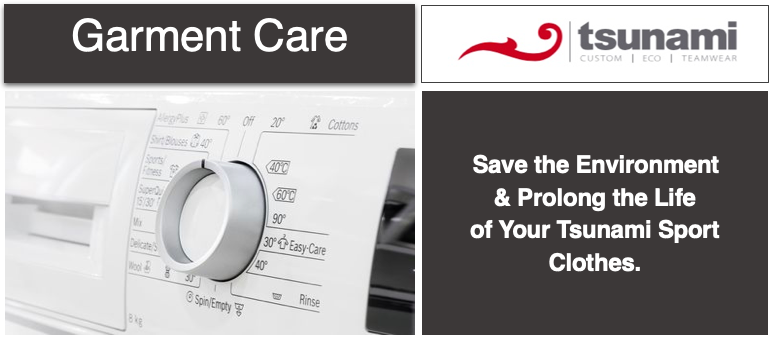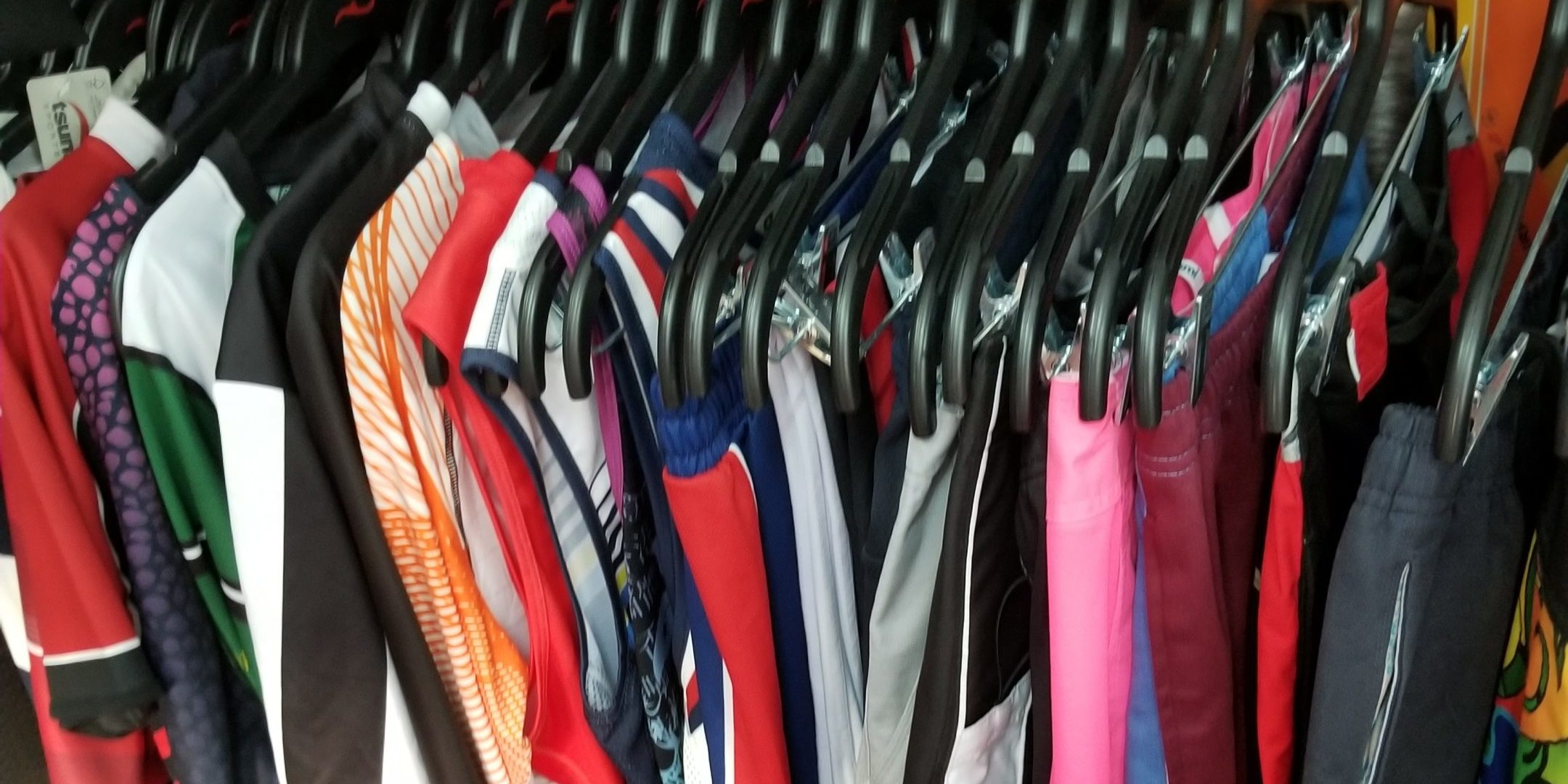Sports performance will expose your Tsunami Sport products to elements like mud, sand, water, gravel, grass and snow which can degrade them.
We’ve put together a guideline for you to get the most out of your gear in the most environmentally friendly manner possible.
General tips to extend the life of your garments and special instructions for Tsunami fabrics as they are mostly made of Polyester.
Polyester Facts:
• Synthetic plastic fibre, also known as PET.
• Resistant to stretching, shrinking, abrasion, wrinkles, and mildew.
• Easily washed and quick-drying, sensitive to heat.
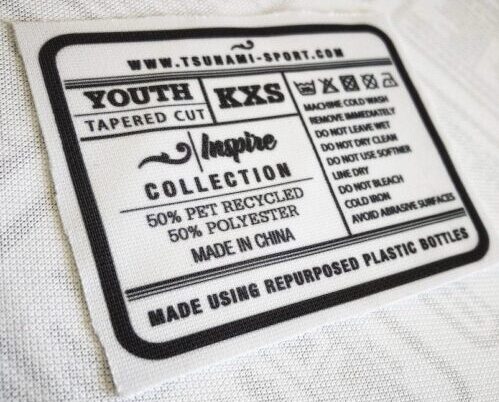
STAINS

To reduce permanent stains, treat as quickly as possible.
Start by sponging the stain to remove as much as possible before treatment. Never rub the stain as it can cause the stain to spread or force the stain deeper into the fabric. Rubbing can also cause abrasion damage to the fabric.
WASHING

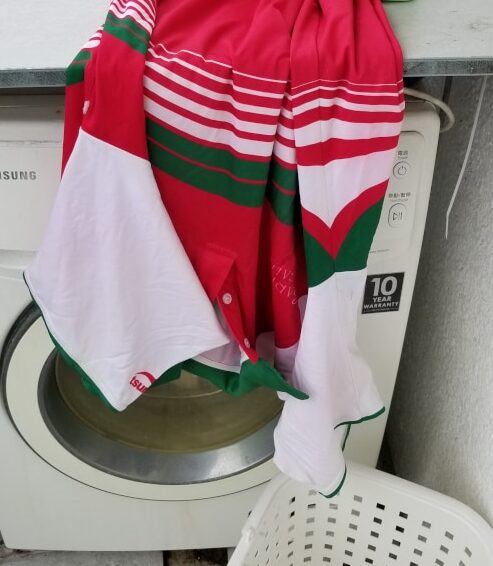
Do not wash clean clothing.
Excessive washing causes clothing to wear out faster, so wearing a garment multiple times before washing extends the life of the garment.
Wash clothes at cool temperature, and our easy-care fabric will thank you.
Polyester fabrics can be washed in a normal cycle or by hand in cold water or mild-warm water with mild detergent.
Heat can cause shrinkage and hardness to this fabric, as well as colour fading. Therefore 30 degrees should be the maximum. Good for you and the planet – as electricity and water will be saved.
We also recommend washing your sportswear inside out – this prevents snagging and colour fading.

Wash with similar colours to prevent colour bleeding.
For Polyester clothes, prevent washing them with other heavily dirty soiled or greasy clothes too– as the Polyester fibres will absorb these stains quickly and you will find your new relatively fresh clothing come out muddy, with a dirty colour to it.

Ensure that garments are completely closed up.
Zip-up all zippers, secure any hooks or loops, and close all snaps and buttons reduce snags and damage from washing.
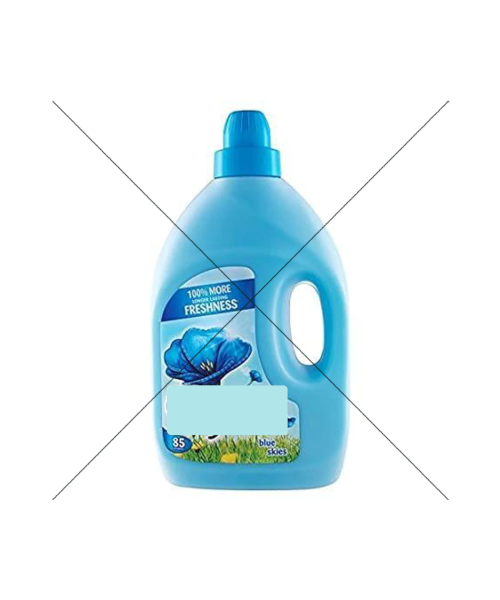
Refrain from adding fabric softener.
While it reduces static cling, the chemicals also affect the moisture-wicking abilities of your favourite Tsunami T-shirt. The softener coats the surface with a wax-like layer, which ultimately prevents sweat from evaporating, and your sportswear starts smelling more quickly. You can use vinegar instead. It will help to neutralize the static electricity. Pour in 1/4 cup into the machine and you’re set.
Additional risks associated with fabric softener:
• A major ingredient in many fabric softeners is Quaternary Ammonium Compounds (QACs or “quats”). It’s used to help combat static but can cause skin and respiratory irritation. Medical studies found an increase in asthma in those who used cleaning products with quats and those regularly exposed to them.
• Quats don’t easily biodegrade, especially in water, and can be toxic to aquatic organisms. This is extra worrisome since–as a laundry product–they go directly into our water systems.
• Fabric softeners can also contain petroleum or palm oil derived ingredients and might not be cruelty-free/vegan; an ingredient found in some fabric softeners is Dihydrogenated tallo dimethyl ammonium chloride, which is derived from animal fat.

| Bleaching destroys Polyester fibres. Additionally it is bad for the environment as the bleach added wastewater is toxic for the soil. Baking Soda – as alternative For this method, mix Baking Soda with water (one part baking soda to two parts warm water) to create a thin paste. Apply some of the paste onto the stained fabric using a soft-bristled brush. For the best results, brush it onto both sides. Let the fabric sit for at least one hour—this will give the baking soda ample time to set into the fibres. Once the time is up, you can wash them as normal. |

Do not dry clean.
Dry cleaning can be controversial because of the toxicity of the chemicals it uses to both humans and the environment. Tetrachloroethylene, for example, is a common soil and water contaminant that is extremely difficult to clean up. Thankfully, modern day regulations are strict regarding solvent emissions, so most modern dry cleaning machines extract and recapture 99.9% of the solvent used in the process.
DRYING
Please do not leave polyester clothes soaked in washing solution for a long period of time. This will cause a bad smell as the dark, wet environment is a great breeding ground for bacteria.

Hang dry your clothes and do NOT tumble dry. Sunshine is good for your garment and dryers destroy and shrink synthetic sportswear products.

Iron at low temperature as Polyester can scorch and melt.
Polyester fabrics do not wrinkle much in general, so you may not need to iron them anyways.
STORAGE
To keep your gear safe for next season, store in a clean, dust-free and dry environment.
SPEAKING ABOUT MICROPLASTICS
The attention on microplastic has risen dramatically in recent years. Microplastics are tiny pieces of plastic, which enter rivers and oceans, accumulate toxins and work their way up the marine food chain from small fish to us.
One important source of microplastic pollution is plastic microfibers that rub off of synthetic fabrics, which are made of virgin or recycled plastic, in the washing machine and are too small for water treatment plants to block.
Tsunami Sport takes the microfiber problem very seriously as most of its fabric is made of Polyester, one of the most common types of synthetic fabrics.
To reduce the production of microfibers in your washing machine, Tsunami Sport has adopted a special seam in the workmanship of its T-shirts. This seam is called “Closed hem” and is located at the bottom of the shirts to secure and protect the individual fibres in the knit from the rough washing machine spinning.
Nevertheless, this only prevents a small amount of microfibers from being released. Therefore, here is some more advice how to prevent microplastic while washing Tsunami Products.
Install a Washing Machine Filter:
Planet Care developed a thoroughly tested washing machine filter that catches at least 80% of the released plastic fibres before they disappear down the drain. Regulations may follow that require manufacturers to incorporate the filter in new washing machines as a matter of course.
Apart from this, for washing machines now that do not have the filter, Planet Care is developing several add-on applications. Solutions for industrial washing facilities are also at an advanced stage.


Use washing machine tools:
At the moment, there are also other solutions to prevent microfiber pollution from synthetic clothes available to the public:
• Guppyfriend, washing machine bag
• Cora Ball, microfiber-catching laundry ball
• Filtrol 160, washing machine lint filter
• Lint LUV-r, washing machine discharge filter
• Xeros Technologies, washing machine filter
Adopt sustainable washing habits:
Here are some extra “anti-microfiber laundry tips” to reduce the number of fibres shed:
• Fill up your washing machine to the max: washing a full load results in less friction between the clothes and, therefore, fewer fibres are released.
• Use washing liquid instead of powder: the ‘scrub’ function of the grains of the powder results in loosening the fibres of clothes more than with liquid.
• Wash at a low temperature: when clothes are washed at a high temperature some fabrics are damaged, leading to the release of fibres.
• Avoid long washings: long periods of washing cause more friction between fabrics, which supposes more tearing of the fibres.



